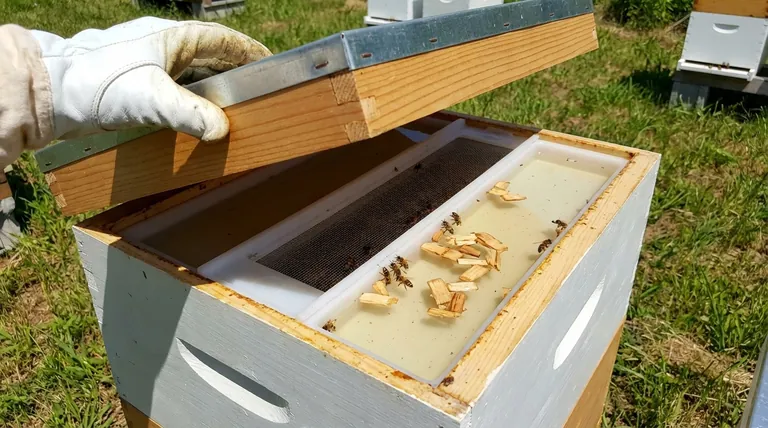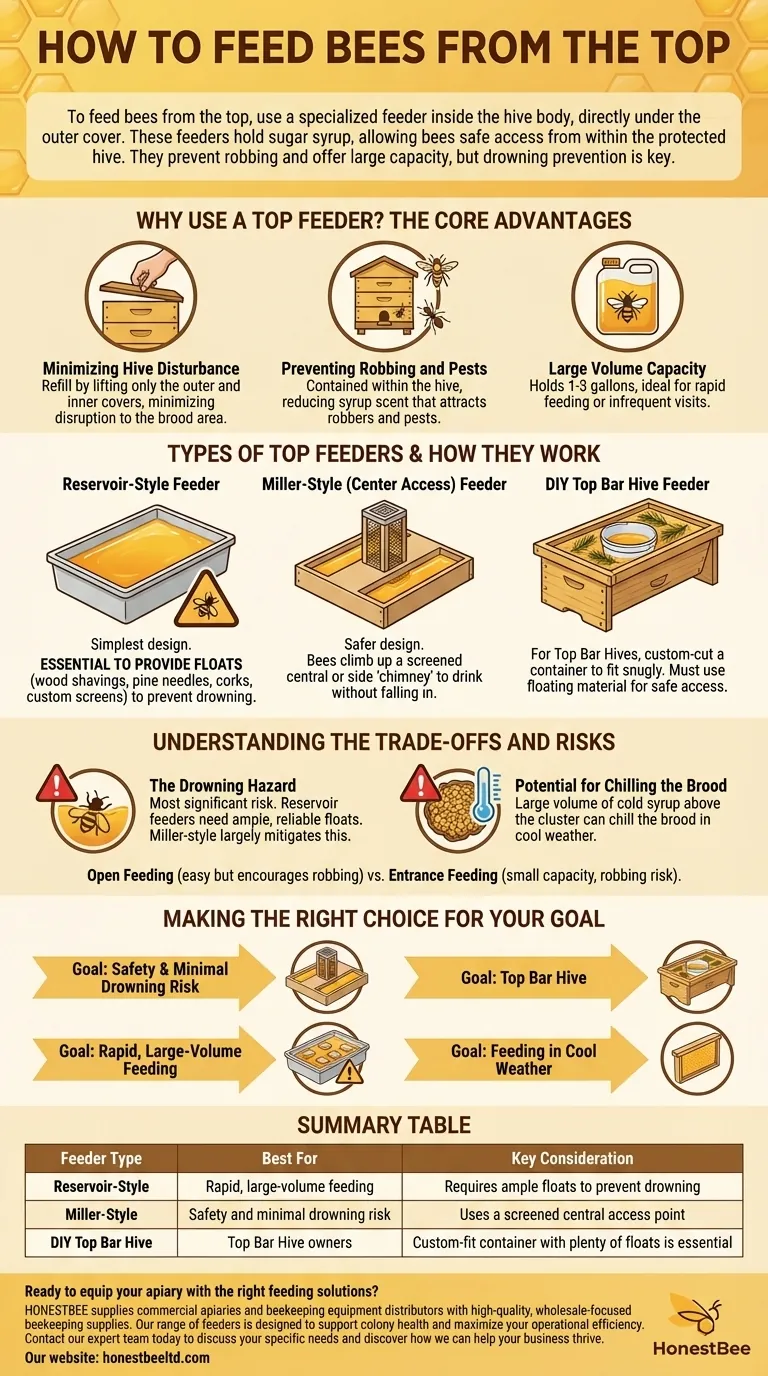To feed bees from the top, you use a specialized feeder placed inside the hive body, directly under the outer cover. These feeders are essentially containers designed to hold sugar syrup, allowing bees to access the food from within the protected hive environment. The most common designs are large reservoirs with floats for the bees to stand on, or feeders that allow bees to climb up through a screened channel to access the syrup from above.
Top hive feeders are a preferred method for their convenience, large capacity, and ability to prevent robbing by outside insects. However, their effectiveness hinges on selecting a design that actively prevents bees from drowning, which remains the single biggest risk associated with this method.

Why Use a Top Feeder? The Core Advantages
Top feeders are a popular choice among beekeepers because they solve several common challenges associated with supplemental feeding.
Minimizing Hive Disturbance
Because top feeders sit above the brood and honey supers, you can often refill them by simply lifting the outer and inner covers. This allows you to provide food with minimal disruption to the colony's critical brood-rearing area.
Preventing Robbing and Pests
Unlike entrance or open-air feeders, a top feeder is contained entirely within the hive. This drastically reduces the scent of sugar syrup that can attract robbing bees from other colonies, as well as wasps, ants, and other pests.
Large Volume Capacity
Most commercial top feeders can hold one to three gallons of syrup. This large capacity is ideal for feeding a colony rapidly or for ensuring they have a consistent food supply when you are unable to visit the hive frequently.
Types of Top Feeders and How They Work
While the principle is the same, top feeder designs vary, primarily in how they give bees access to the syrup while attempting to prevent drowning.
The Reservoir-Style Feeder
This is the simplest design: a large, open tray that holds the syrup. For this feeder to be safe, it is absolutely essential to provide floats for the bees. Bees must have a non-stick surface to land on and drink from, otherwise, they will drown in huge numbers.
- Floats can include: wood shavings, pine needles, corks, or custom-cut plastic screens.
The Miller-Style (Center Access) Feeder
This design is often considered safer. The syrup is held in two separate channels, and bees access it by climbing up from the hive through a central or side "chimney" covered by a screen. They can drink through the screen without ever being able to fall into the main reservoir.
The DIY Top Bar Hive Feeder
Commercial feeders are typically designed for Langstroth hives. For Top Bar Hives, a common DIY method involves cutting a plastic bucket or container to fit snugly inside one end of the hive. Just like with a reservoir feeder, you must fill it with floating material like pine needles to provide safe access for the bees.
Understanding the Trade-offs and Risks
While convenient, top feeders are not without their downsides. Being aware of them is key to using this method successfully.
The Drowning Hazard
This is the most significant risk. If you use a reservoir-style feeder without enough floats, or if the floats become soaked and sink, you can lose thousands of bees. Miller-style feeders largely mitigate this risk.
Potential for Chilling the Brood
Placing a large volume of cold syrup directly above the bee cluster, especially in cooler spring or fall weather, can act as a "cold sink." This can make it harder for the bees to maintain the necessary temperature in the brood nest below.
Comparison to Other Methods
Top feeders are one of many options. Open feeding (placing syrup in a bucket outside) is easy but can encourage widespread robbing. Entrance feeders are simple but have very small capacity and can also incite robbing right at the hive entrance. Knowing multiple methods allows you to adapt to the colony's specific needs.
Making the Right Choice for Your Goal
Select your feeding strategy based on your specific objective and equipment.
- If your primary focus is safety and minimal drowning risk: Choose a Miller-style feeder with a screened central access point.
- If your primary focus is rapid, large-volume feeding: Use a reservoir-style feeder, but ensure you add ample floats like wood shavings or a plastic screen.
- If you have a Top Bar Hive: A custom-fit DIY feeder using a bucket with plenty of floats is your most practical solution.
- If you are feeding in cool weather: Consider using a smaller volume of syrup or an alternative like an in-hive frame feeder to avoid chilling the brood nest.
By understanding these principles, you can confidently choose and use a top feeder to effectively support your colony's health and growth.
Summary Table:
| Feeder Type | Best For | Key Consideration |
|---|---|---|
| Reservoir-Style | Rapid, large-volume feeding | Requires ample floats (e.g., wood shavings) to prevent drowning |
| Miller-Style | Safety and minimal drowning risk | Uses a screened central access point for safe bee access |
| DIY Top Bar Hive | Top Bar Hive owners | Custom-fit container with plenty of floats is essential |
Ready to equip your apiary with the right feeding solutions? HONESTBEE supplies commercial apiaries and beekeeping equipment distributors with high-quality, wholesale-focused beekeeping supplies. Our range of feeders is designed to support colony health and maximize your operational efficiency. Contact our expert team today to discuss your specific needs and discover how we can help your business thrive.
Visual Guide

Related Products
- HONESTBEE Advanced Ergonomic Stainless Steel Hive Tool for Beekeeping
- Professional Dual-End Stainless Steel Hive Tool for Beekeeping
- Professional 3-Bar Frame Grip with Integrated Hive Tool
- Metal Bee Hive Stand Bee Box Stand for Beekeeping
- Beehive Handle and Frame Rest Cutting Machine: Your Specialized Hive Machine
People Also Ask
- What are the basic tools for beekeeping? Essential Starter Kit for Safe & Successful Hive Management
- Why do hive tools have a hole? Unlock the Secret to Efficient Beekeeping
- What are some common uses of a hive tool? Essential Multi-Purpose Tool for Every Beekeeper
- How should beekeepers handle bees when using a hive tool? Master Calm, Deliberate Techniques
- Why is it important to compare the progress of different hives? A Beekeeper's Key Diagnostic Tool



















